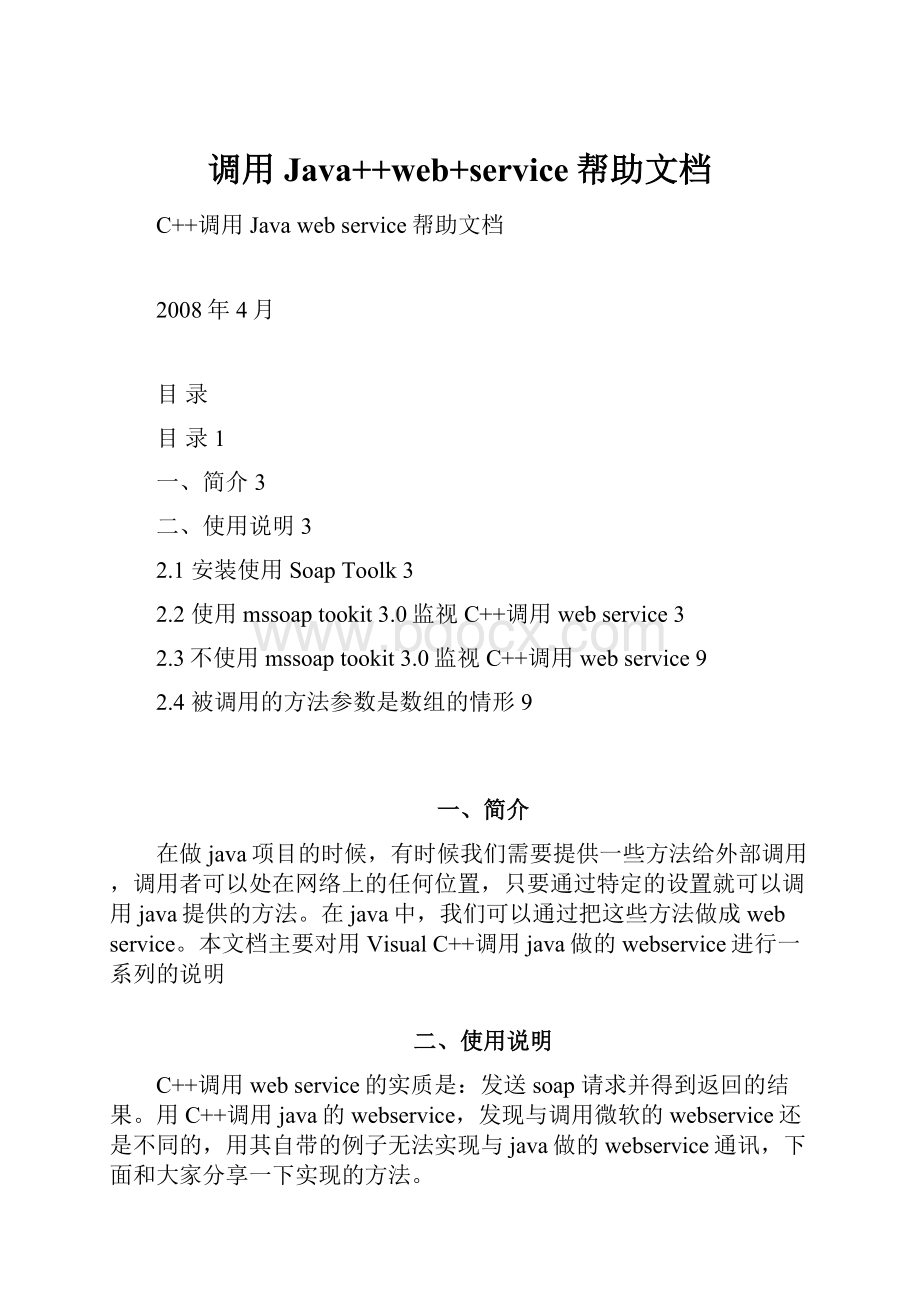调用Java++web+service帮助文档.docx
《调用Java++web+service帮助文档.docx》由会员分享,可在线阅读,更多相关《调用Java++web+service帮助文档.docx(12页珍藏版)》请在冰豆网上搜索。

调用Java++web+service帮助文档
C++调用Javawebservice帮助文档
2008年4月
目录
目录1
一、简介3
二、使用说明3
2.1安装使用SoapToolk3
2.2使用mssoaptookit3.0监视C++调用webservice3
2.3不使用mssoaptookit3.0监视C++调用webservice9
2.4被调用的方法参数是数组的情形9
一、简介
在做java项目的时候,有时候我们需要提供一些方法给外部调用,调用者可以处在网络上的任何位置,只要通过特定的设置就可以调用java提供的方法。
在java中,我们可以通过把这些方法做成webservice。
本文档主要对用VisualC++调用java做的webservice进行一系列的说明
二、使用说明
C++调用webservice的实质是:
发送soap请求并得到返回的结果。
用C++调用java的webservice,发现与调用微软的webservice还是不同的,用其自带的例子无法实现与java做的webservice通讯,下面和大家分享一下实现的方法。
1.首先,需要安装微软的mssoaptookit3.0工具包,可以从微软的官方网站上下载;
2.使用java建立一个web服务 ,本例子的webservice使用开源项目cxf建立起来的,想了解cxf请登陆:
http:
//incubator.apache.org/cxf/
2.1安装使用SoapToolk
首先C++要调用webservice,首先要下载mssoaptookit3.0工具包,并安装好。
mssoaptookit必须是3.0,否则会出现错误。
默认安装好mssouptookit3.0後,就可以使用C++来调用webservice了。
这时候可以使用mssoaptookit3.0来监控C++的soap请求。
现在假设网络上有一个webservice:
http:
//192.168.0.10:
8082/ServiceGateway/ServiceServer,下面就这个webservice来详细描述使用mssoaptookit3.0来监控C++调用webservice的情形和不监控的情形,
2.2使用mssoaptookit3.0监视C++调用webservice
要想使用mssoaptookit3.0来监控,首先请打开TraceUtility。
打开时候请新建一个FormattedTrace,如下图
这时候会弹出一个如下图的窗口:
Localport,可以自己定义,使用本机上的一个空闲的端口即可,本例设置为:
8080,该端口的意义:
以后使用该端口来发送soap请求,Destination:
localhos中的localhost请设置为webservice的IP,本例应该设置为:
192.168.0.10,Destination:
80请设置为webservice的端口,本例设置为:
8082,设置好之后就可以通过localport来监控soap请求了。
先查看wsdl文件:
http:
//192.168.0.10:
8082/ServiceGateway/ServiceServer?
wsdl
xmlversion="1.0"encoding="utf-8"?
>
-definitionsxmlns:
wsdl="http:
//schemas.xmlsoap.org/wsdl/"xmlns:
soap="http:
//schemas.xmlsoap.org/wsdl/soap/"xmlns:
tns="http:
//gateway/"xmlns:
xsd="http:
//www.w3.org/2001/XMLSchema"name="IndexServiceService"targetNamespace="http:
//gateway/">
-types>
-schemaattributeFormDefault="unqualified"elementFormDefault="unqualified"targetNamespace="http:
//gateway/"xmlns:
tns="http:
//gateway/"xmlns:
xsd="http:
//www.w3.org/2001/XMLSchema">
elementname="numList"type="tns:
numList"/>
-complexTypename="numList">
-sequence>
elementname="arg0"type="xsd:
int"/>
elementmaxOccurs="unbounded"minOccurs="0"name="arg1"type="xsd:
int"/>
sequence>
complexType>
elementname="numListResponse"type="tns:
numListResponse"/>
-complexTypename="numListResponse">
-sequence>
elementmaxOccurs="unbounded"minOccurs="0"name="return"type="xsd:
int"/>
sequence>
complexType>
elementname="login"type="tns:
login"/>
-complexTypename="login">
-sequence>
elementminOccurs="0"name="arg0"type="xsd:
string"/>
sequence>
complexType>
elementname="loginResponse"type="tns:
loginResponse"/>
-complexTypename="loginResponse">
-sequence>
elementminOccurs="0"name="return"type="xsd:
string"/>
sequence>
complexType>
schema>
types>
-messagename="loginResponse">
partelement="tns:
loginResponse"name="parameters"/>
message>
-messagename="login">
partelement="tns:
login"name="parameters"/>
message>
-messagename="numListResponse">
partelement="tns:
numListResponse"name="parameters"/>
message>
-messagename="numList">
partelement="tns:
numList"name="parameters"/>
message>
-portTypename="IndexService">
-operationname="numList">
inputmessage="tns:
numList"name="numList"/>
outputmessage="tns:
numListResponse"name="numListResponse"/>
operation>
-operationname="login">
inputmessage="tns:
login"name="login"/>
outputmessage="tns:
loginResponse"name="loginResponse"/>
operation>
portType>
-bindingname="IndexServiceServiceSoapBinding"type="tns:
IndexService">
bindingstyle="document"transport="http:
//schemas.xmlsoap.org/soap/http"/>
-operationname="numList">
operationsoapAction=""style="document"/>
-inputname="numList">
bodyuse="literal"/>
input>
-outputname="numListResponse">
bodyuse="literal"/>
output>
operation>
-operationname="login">
operationsoapAction=""style="document"/>
-inputname="login">
bodyuse="literal"/>
input>
-outputname="loginResponse">
bodyuse="literal"/>
output>
operation>
binding>
-servicename="IndexServiceService">
-portbinding="tns:
IndexServiceServiceSoapBinding"name="IndexServicePort">
addresslocation="http:
//192.168.0.10:
8082/ServiceGateway/ServiceServer"/>
port>
service>
definitions>
可见有两个远程方法:
int[]numList(int,int[])
Stringlogin(String)
用vc建立一个console的程序,其全部代码如下:
//testwebservice.cpp:
Definestheentrypointfortheconsoleapplication.
//
#include"stdafx.h"
#include
#import"msxml4.dll"
usingnamespaceMSXML2;
#import"C:
\ProgramFiles\CommonFiles\MSSoap\Binaries\mssoap30.dll"\
exclude("IStream","IErrorInfo","ISequentialStream","_LARGE_INTEGER",\
"_ULARGE_INTEGER","tagSTATSTG","_FILETIME")
usingnamespaceMSSOAPLib30;
voidAdd()
{
ISoapSerializerPtrSerializer;
ISoapReaderPtrReader;
ISoapConnectorPtrConnector;
//Connecttotheservice.
Connector.CreateInstance(__uuidof(HttpConnector30));
//使用EndPointURL属性指定Web服务,因为使用soaptookit3.0来监控,所以使用本地的8080端口来发送soap请求
Connector->Property["EndPointURL"]="http:
//localhost:
8080/ServiceGateway/ServiceServer";
//这是不使用mssoaptookit3.0来监控的情形,需要直接发送请求到远端的端口。
//Connector->Property["EndPointURL"]="http:
//192.168.0.10:
8082/ServiceGateway/ServiceServer";
Connector->Connect();
//开始消息
////在与服务器连接后,我们需要指定Web服务完成的操作。
//为了指定该操作,我们需要再次使用SoapConnector的Property属性
Connector->Property["SoapAction"]="http:
//localhost:
8080/ServiceGateway/ServiceServer";
//这是不使用mssoaptookit3.0来监控的情形
//Connector->Property["SoapAction"]="http:
//192.168.0.10:
8082/ServiceGateway/ServiceServer";
Connector->BeginMessage();
//CreatetheSoapSerializerobject.
Serializer.CreateInstance(__uuidof(SoapSerializer30));
//Connecttheserializerobjecttotheinputstreamoftheconnectorobject.
Serializer->Init(_variant_t((IUnknown*)Connector->InputStream));
//创建SOAP消息
Serializer->StartEnvelope("","","");
Serializer->StartBody
//开始SOAP消息中的一个元素,第一个参数描述了名字空间,是wsdl文件中的:
//targetNamespace="http:
//gateway/"
//如果它是空值,就会缺省地使用SOAP-ENV。
第二、第三个参数
//调用login方法,参数名由wsdl文件决定:
//complexTypename="login">
//sequence>
//elementminOccurs="0"name="arg0"type="xsd:
string"/>
//
sequence>
//
complexType>
Serializer->StartElement("login","http:
//server.hw/","STANDARD","");
Serializer->StartElement("arg0","","STANDARD","");
Serializer->WriteString("cellcom");
Serializer->EndElement();
Serializer->EndElement();
Serializer->EndBody();
Serializer->EndEnvelope();
//将该消息发送给web服务
Connector->EndMessage();
////读取响应
.
Reader.CreateInstance(__uuidof(SoapReader30));
//将reader联接到connector的输出字符串
Reader->Load(_variant_t((IUnknown*)Connector->OutputStream),"");
//显示结果
printf("Answer:
%s\n",(constchar*)Reader->RpcResult->text);
return;
}
intmain(intargc,char*argv[])
{
CoInitialize(NULL);
Add();
CoUninitialize();
return0;
}
上面的代码是一个完整的C++调用webservice的情形,运行之后会发现TraceUtility里有些信息,如下图:
第一个框里是一个soap请求,第二个框是soap请求返回的结果。
2.3不使用mssoaptookit3.0监视C++调用webservice
不使用mssoaptookit3.0监控的时候,C++的代码要做如下修改:
//使用EndPointURL属性指定Web服务,因为使用soaptookit3.0来监控,所以使用本地的8080端口来发送soap请求
//Connector->Property["EndPointURL"]="http:
//localhost:
8080/ServiceGateway/ServiceServer";
//这是不使用mssoaptookit3.0来监控的情形,需要直接发送请求到远端的端口。
Connector->Property["EndPointURL"]="http:
//192.168.0.10:
8082/ServiceGateway/ServiceServer";
Connector->Connect();
//开始消息
////在与服务器连接后,我们需要指定Web服务完成的操作。
//为了指定该操作,我们需要再次使用SoapConnector的Property属性
//Connector->Property["SoapAction"]="http:
//localhost:
8080/ServiceGateway/ServiceServer";
//这是不使用mssoaptookit3.0来监控的情形
Connector->Property["SoapAction"]="http:
//192.168.0.10:
8082/ServiceGateway/ServiceServer";
//要使用http:
//192.168.0.10:
8082/ServiceGateway/ServiceServer来指定服务。
//其他的基本上没改变。
2.4被调用的方法参数是数组的情形
下面是调用numList的情形,通过查看wsdl知道,numList有两个参数:
complexTypename="numList">
-sequence>
elementname="arg0"type="xsd:
int"/>
elementmaxOccurs="unbounded"minOccurs="0"name="arg1"type="xsd:
int"/>
sequence>
complexType>
通过询问webservice的开发人员知道,第一个参数是int,第二个参数是int[],该方法是把int[]里所有在第一参数之前的数加一,
Serializer->StartEnvelope("","","");
Serializer->StartBody("");
//开始SOAP消息中的一个元素,第一个参数描述了名字空间,
//如果它是空值,就会缺省地使用SOAP-ENV。
第二、第三个参数
Serializer->StartElement("numList","http:
//gateway/","STANDARD","");
Serializer->StartElement("arg0","","STANDARD","");
Serializer->WriteString("2");
Serializer->EndElement();
Serializer->StartElement("arg1","","STANDARD","");
Serializer->WriteString("53");
Serializer->EndElement();
Serializer->StartElement("arg1","","STANDARD","");
Serializer->WriteString("58");
Serializer->EndElement();
查看soap监控里的信息: